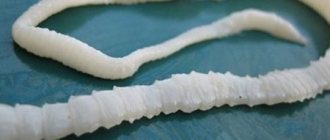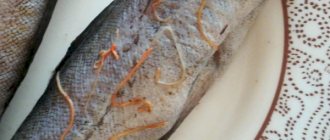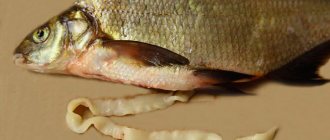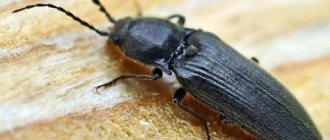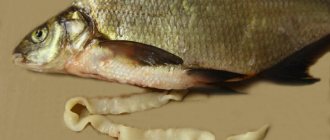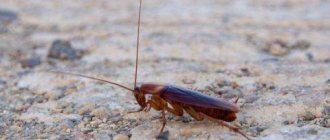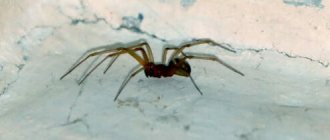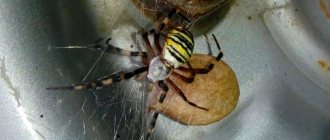River or sea fish are a source of protein and many minerals that are not found in meat products.
There are practically no fish that do not have parasites. But most of them are harmless to human health. In addition, some parasites in fish are negligible and occur in minute quantities, which cannot adversely affect the quality of fish products.
But there are cases when, due to parasites, fish could not be eaten, and tons of it were sent for technical needs.
Worms in fish that are safe for humans
Finding parasites is often an unpleasant and unappetizing moment. But not all fish worms are dangerous to humans.
The following species do not pose a threat to human health:
- Flatworms (diplostomas);
- Roundworms (polymeters);
- Tapeworms (several types).
Diplostomy
The main places for parasitism of this worm are the eyes, gill compartments, and the area of the pectoral fins. A certain type of this worm lives exclusively in the eyes of fish, as a result of which the fish notices clouding of the eyes and loss of vision in the future.
This type of worm is found in fish that live in fresh water; the families of perch and carp fish are mainly affected, most often perch and roach.
This parasite is white in color, can reach 70-80 cm in length, and has a flat appearance, similar to flat homemade noodles.
Pilometra
The habitat of this parasite is quite far away, in the southern parts of the Pacific Ocean. However, in the CIS countries there have been cases of detection of this worm in imported fish.
It occurs in individuals depending on gender. In females, the worm lives in scaly pockets, and in males, inside the swim bladder. Fish of the carp family are susceptible to this parasite.
The parasite is red in appearance and can be about 10 cm long. Properly cleaned fish can be eaten. For better insurance, fish in which this type of worm is found is fried; heat treatment completely neutralizes these parasites.
Tapeworms
Ligula intestinalis is a tapeworm. One of the longest parasites present in fish, the average individual reaches a length of 100 centimeters.
The Ligulidae, just like the common Ligulidae, conducts a similar lifestyle in the body of aquatic inhabitants. It differs only in size, it parasitizes small individuals, the length of the worm is 3-5 cm.
Treatment and prevention
Fish can get helminthiasis even with the best and most careful care. It is important to notice the disease in time. Monitor the condition of the fish daily; when feeding, you need to pay attention to the possible appearance of symptoms of disease and unusual behavior.
There are not many methods for treating worms:
- Kamala and Fenasal. These drugs are mixed into the food and given in accordance with the recommendations specified in the instructions. Treatment is carried out when transferring fish to wintering ponds in the fall or in the spring when transplanting from wintering ponds to feeding ponds.
- Therapeutic baths. You can fight flukes (trematodes) with the help of antiparasitic baths, for which the fish are placed in a 5% solution of table salt for 5 minutes; ammonia baths are used to treat the fry.
The main emphasis is on regular prevention and ongoing measures:
- It is not recommended to keep old and young fish in the same pond;
- There should be no infected fish in the reservoir; if found, it must be immediately removed from healthy ones;
- for wintering, fish are moved from a man-made reservoir;
- until winter comes, the pond water is drained, and only starts up in the spring, and at this time his land is disinfected with phosphorus chloride, after which it is plowed;
- it is necessary to scare away birds from reservoirs that feed on fish, because they are carriers of helminths in this chain, and to control that such birds do not settle (weave nests) near ponds - it is necessary to mow down hard and emergent plants.
Electric fishing rods are used to catch infected fish. Sick fish are more sensitive to electricity, so they can be easily caught.
It is recommended to bury dead infected fish deep in the soil. Do not place them on a surface! Fish-eating birds living near the pond will eat them and provide a new cycle of development of fish parasites.
Worms in fish that are dangerous to humans
Do not forget that only a small percentage of parasites found in fish are not dangerous to humans. Eating raw or semi-raw foods can lead to serious complications.
Parasites found in both freshwater and sea fish that are dangerous to the body:
- Clonorchis;
- Anisakids;
- Opisthorchis;
- Diphylobothrium.
Clonorchis and opisthorchis
They belong to the order of flatworms (trimatodes), the main habitats of this parasite are mollusks. Among river inhabitants it is found in the carp family (carp, roach, bream, carp, etc.).
Smaller individuals of this parasite also live in small fish; subsequently they can be found in animals and birds that have consumed infected meat.
Parasites of the subspecies of trimatodes perform the function of flukes, sticking to the walls of the stomach of fish, animals or birds, which leads to further death of parts of the stomach and tissue necrosis in general.
Trimatodes are predominantly red in color and reach a length of 10 cm (large worm) and 2-3 cm (small parasite).
Anisakids
The most harmful parasites living in fish. They are considered the most dangerous worms for the human body due to their transient parasitism.
Anisakids are divided into two types:
- Anisakissimplex
- Pseudoterranova
Anisakissimplex – better known as the herring worm, is primarily found in pollock, mackerel and herring.
Pseudoterranova - cod worms, differ from the first species in smaller size and are found exclusively in cod. This type of parasite is resistant to low temperatures; even living specimens of this worm were found in a frozen carcass. The site of parasitism is predominantly the liver.
They enter the human body through consumption of improperly prepared, raw or lightly salted fish.
Diphyllobothrium
There are 3 types of cestodes that can infect the human body:
- Latum;
- Dendriticum;
- Nihonkiense.
The most dangerous latum is better known as the broad tapeworm. It is one of the longest worm-like parasites. The length of the parasite reaches 10 meters, life expectancy is 20 years.
The parasite grows by changing its owner. The first habitat of the tapeworm larvae are crustaceans or small individuals, then the maturation of the parasite individual can occur together with the maturation and growth of its inhabitant, or when the host eats larger fish.
Even in a large fish, the parasite may be in the larval stage and when it is cut, the parasite may not be noticed. Therefore, it is not recommended to eat raw or semi-raw fish.
The most susceptible fish species to infection
Not all fish species, both marine and freshwater, are equally susceptible to infection by various parasites. The most susceptible species susceptible to parasite infection include:
- Crucian carp . Living in the middle zone, this common inhabitant of various bodies of water rarely causes infection. Living within the Far East, this fish often becomes the object of infection with clonorchiasis.
- Yazya . It is believed that ide is an omnivorous fish, therefore it is most susceptible to infection by the Siberian fluke, which can cause many dangerous ailments.
- Bream . Living in the middle zone, as well as in warmer regions, this fish is a carrier of ligulosis.
- Perch , eating which without careful processing can become infected with ligulosis and diphyllobothriasis. Diphyllobothrium latum larvae are found in the gills of fish. This parasite poses a serious threat to human health.
- Linya . As a rule, this fish lives in reservoirs with dense thickets of aquatic vegetation, as well as a muddy bottom. In such conditions, the cat fluke develops well, which can cause a disease such as opisthorchiasis.
- Pollock . This seafood, which is often found on store shelves, can infect a person with anisakiasis, a very dangerous disease.
- Flounder . Many helminths can live in this fish, so it is generally not recommended to eat it without heat treatment.
Note to the hostess! Preparing dishes from the above-mentioned fish species requires high-quality heat treatment. These types of fish are not recommended to be consumed lightly salted, and especially raw.
What diseases are caused by worms in fish?
Many consider fish meat to be the safest food product than the meat of birds and mammals, due to single outbreaks of bird and swine flu.
Unfortunately, even eating fish can infect the human body, if not fatally, then with a very serious illness.
Diseases associated with eating fish meat with parasites include:
- Diphylobothriasis;
- Opisthorchiasis;
- Anisakidosis;
- Clonorchiasis;
- Metagominosis;
- Heterophyosis.
Anisakidosis
Herring and cod worms, as well as pollock worms, prefer to parasitize in the fish body, but in the human body they linger for a short time and try to get out.
Despite their short stay in the human body, worms can cause significant harm to the body.
The presence of this parasite in the body is indicated by the following symptoms:
- Nausea;
- Vomit;
- Weakness;
- Heat;
- Diarrhea;
- Flatulence;
- Pain in the pancreas or stomach;
- Allergic reaction (hives, swelling of the eyes, face, etc.)
Diphylobothriasis
The causative agent of diphylbothriasis is the broad tapeworm. Unlike the previous parasite, the tapeworm is well adapted to living in the human body. The lifespan of a tapeworm in the human body is about 10–15 years, while the length of the parasite reaches 12 meters.
This disease is very asymptomatic; the carrier may not be aware of the presence of the parasite. Moreover, such rare symptoms as abdominal pain, frequent diarrhea, nausea and belching are considered to be the consumption of junk food.
Also present in the symptoms of diphylbothriasis are:
- Drowsiness;
- Loss of taste or strange aftertaste;
- Allergic rashes or hives;
- Weight loss;
- Vomit;
- Loss of appetite.
Note! Diphylobothriasis in advanced stages leads to atrophy of the pancreas.
Clonorchiasis and opisthorchiasis
These two diseases are similar in their symptoms, so opisthorchiasis is often classified as clonorchiasis. The causative agent is the parasites clonorchis or Chinese flukes, which are classified as liver flukes.
The habitat of these worms is the stomach and liver. The carrier of this parasite has a high chance of developing jaundice, pancreatitis, hepatitis, which can subsequently develop into cirrhosis of the liver.
The symptoms of the presence of the parasite are quite extensive:
- Temperature rise;
- Yellowing of the whites of the eyes;
- Inflammation of the lymph nodes;
- Pain in the liver;
- Diarrhea;
- Overexcitation or state of inhibition;
- Lack of sleep.
Heterophyosis and metagonimiasis
The worm is localized in the human intestine; the eggs of the parasite can reach the brain through the bloodstream. The chronic course of the disease is caused by prolonged diarrhea, salivation, and pain in the abdomen. Heterophyosis is also a causative agent of enteritis. Metagonimiasis is characterized by a stable temperature of 38-39°C.
Symptoms of heterophyosis are:
- Stomach upset (diarrhea or constipation);
- Allergic reactions;
- Migraine;
- Nausea and vomiting.
What are the symptoms of infection and how to avoid it?
A person becomes infected if he eats raw or insufficiently heat-treated fish that contains live larvae. The incubation period after infection with parasites can last from one to two weeks. As a rule, in an infected person, symptoms manifest themselves in the form of eating disorders, deterioration of general condition and loss of body weight. In this case, clinical signs may be absent for a long time or have uncharacteristic manifestations. Very often the clinical picture is similar in symptoms to diseases of the gastrointestinal tract, such as gastritis or pancreatitis.
To avoid infection, you should not buy fish from unauthorized retail outlets. In addition, before eating, the fish must be thoroughly fried, boiled and salted. Ideally, you should avoid lightly salted, raw, dried, slightly poached fish. It is better to buy it from enterprises where there is control over compliance with sanitary rules. When cutting fresh fish or crayfish at home, you should use separate utensils and a knife. After finishing cutting, be sure to treat them with disinfectant detergents.
Article on the topic
Summer "surprise". How can you easily get poisoned during the warm season?
How to distinguish infected fish?
In order to distinguish infected fish from healthy ones, when cutting a carcass you need to carefully examine its gills, entrails, etc. Particular attention should be paid to the tissues in the meat, the main habitat of parasites.
It is also worth examining the abdominal walls; black spots indicate the presence of parasitic worms; adult individuals can be detected with the naked eye, which indicates infection.
Let's celebrate! Also, when fishing, you can notice if the fish stays on the surface, behaves quite passively when retrieving or biting - this is the first sign of an unhealthy condition. If a caught fish has a swollen belly, this 90% indicates a rather advanced process of parasitism.
Should I give up fish because of worms?
Most helminths visible in fish are harmless to humans and simply require mechanical removal. The greatest danger is posed by parasites that can live in the muscle tissue of fish. If there are visible helminths in the muscle tissue or visual observation of lesions in the muscle tissue, it is recommended to discard the fish (preferably bury it to avoid infestations of birds or animals).
Proper treatment allows you to get rid of most types of mature helminths and their eggs.
What to do if worms are found in fish?
If there are worms, it is better not to eat meat at all.
But if you are still going to eat fish meat and there is a suspicion that it is infected, then there are several rules that will help you not to become infected yourself:
- Fry or boil meat for at least 20-25 minutes, since heat exposure kills worms and their larvae;
- Bake for more than 30 minutes;
- Salted fish should be eaten 25-30 days after salting; parasites in salted fish die after 2.5 weeks;
- When fish is frozen at -30 °C, the worms die after 6 hours, at -20 °C death occurs within 1.5 days, and at -12 °C after 2.5 days.
How to protect yourself from parasite infection
Knowing that fish can contain various parasites, you should adhere to the cooking technology, subjecting the fish to heat treatment. Such technologies include:
- Cooking.
- Frying.
- Hot smoking.
- Deep ambassador.
- Deep freezing.
If the fish is cooked for at least 20 minutes, then any type of parasites will die in it. If you fry fish, this is another fairly effective way to get rid of parasites, since the temperature is higher than when boiling. Hot smoking also allows you to neutralize parasites, but the duration of treatment should not be less than 2 hours.
In addition to temperature treatment, there are two more options that can protect a person from helminth infection - deep salting and deep freezing. Salt destroys all types of parasites within 2 weeks. If large fish is used for salting, then the processing time should be increased.
Parasites can also be destroyed by deep freezing at a temperature of -40 degrees. In such conditions, the parasites die within 24 hours. Before such a technological procedure, the fish is thoroughly washed under running water.
As you can see, there are enough ways to disinfect fish, so it is not problematic to use any of them.
Recently, it has become fashionable to eat fish without proper temperature treatment, since in such dishes most of the beneficial components, such as minerals and vitamins, are preserved. But then you need to be 100 percent sure that the fish meat does not contain parasites, otherwise healthy food will turn into serious health problems after some time.
HOW TO KILL ALL POSSIBLE PARASITES IN FISH
Which fish doesn't have worms?
You should purchase fish products exclusively from trusted stores, where, if necessary, you can be provided with a certificate of product inspection and compliance with sanitary standards.
Avoid eating dishes with raw or lightly salted fish. When preparing fish, it is important to follow all technical rules and carefully inspect the carcass when purchasing it.
Let's celebrate! You should always be on guard when eating fish dishes. And if parasites are detected, for better health prevention, it would be wise to refuse such fish.
How to avoid getting infected with worms?
Heat treatment, deep freezing, as well as adherence to personal hygiene rules (after processing fish, you must wash your hands with soap) allow you to avoid possible invasions by 99%.
The heat treatment rules are as follows:
- Cooking: at least 15 minutes after boiling.
- Frying: at least 15 minutes.
- Baking: at least 30 minutes at a temperature of 180 degrees.
Freezing at a temperature of minus 16 degrees (the average freezer temperature of a modern refrigerator) should last at least 36 hours for fish weighing less than 2 kg. Salting of fish should be carried out in 15% - 20% brine for at least seven days.
Important! Handicraft production of lightly salted sea fish does not guarantee against infection by parasites.
Preventive measures
To exclude the possibility of infection with parasites through fish, you must adhere to some recommendations:
- do not consume raw fish products;
- strictly adhere to the technology of salting, marinating and smoking;
- subject the raw materials to heat treatment for at least 20 minutes. with a temperature above 65°C;
- the filling for fish pies must undergo preliminary heat treatment or bake for at least 30 minutes;
- When purchasing, pay special attention to the appearance of the fish;
- Do not purchase fish from your own hands, caught in unknown waters.
The freezing process allows you to get rid of parasites invisible to the naked eye: 5 days at -20°C and below, or 1-4 with stronger freezing. After this, the worms in the frozen fish die completely.
On a note!
Many lovers of raw seafood dishes are interested in the question of which fish are free of worms and parasites. They can be advised to use sterlet in cooking or buy fish grown in artificial reservoirs, where the quality and health of the stock is constantly monitored.
Prevention measures
To ensure that contaminated fish does not end up on your table, it is necessary to regularly take certain preventive measures. Consumption of the product in its raw form is strictly prohibited.
If there is an urgent need for this, then certain rules are followed.
To be consumed raw, the product must be grown under artificial conditions. Her nutrition must be artificial. The product must be treated and regularly monitored for the absence of parasites.
If sea fish is used for cooking, it must be frozen on a fishing boat immediately after catching.
The product must be defrosted immediately before consumption. The product is also allowed to be eaten raw immediately after catching.
Almost all types of river fish are characterized by the presence of parasites that pose a danger to human health and life.
Only sterlet can be eaten raw. All other types of products must first undergo a salting, pickling or smoking process in accordance with the developed recommendations.
Only a product that has been thoroughly boiled or fried beforehand is considered safe. These rules must be followed, regardless of the type of fish, since it is impossible to see the presence of microscopic helminth larvae with the naked eye.
Cooking fish should be carried out for at least 20 minutes after it boils. The product must be fried in a well-heated frying pan for the same time. To ensure complete heat treatment, it is recommended to pre-cut the product along the ridge.
Baking pies that contain this product should take at least half an hour. If the product is hot smoked, this process completely kills the helminths before they are ready.
When buying fish, you should give preference to those options that have scales. It should have a characteristic shine and not puff up.
How to avoid getting infected with worms
Adult worms in fish can most often be seen independently. Larvae and eggs, which are much smaller in size, are detected only in laboratory tests. Once you see a photo of worms in fish, it is no longer possible to forget their terrifying appearance. Subsequently, the visual picture can always be compared with the found parasites in order to determine the degree of their harmfulness.
On a note!
Fish with worms is not always a source of infection. Some species, after removing the scales and entrails, become safe. But it's not worth the risk. It is better to get rid of an infected fish carcass.
Helminths in fish
Treatment of helminthic infestations
A significant portion of worms pose a danger only to their immediate owners. A person as a host is not suitable for them, so after a week or two they die and, if you do not eat infected fish constantly, treatment may not be necessary. However, some fish worms take root in the body of Homo sapiens, which has serious consequences - including the development of diseases of the liver, gall bladder, and pancreas. Then patients have to take not only anthelmintic drugs to get rid of parasites, but also drugs that restore the affected gastrointestinal microflora.
If the destructive effect of worms on internal organs has not gone too far and the number of parasitic colonies is not too large, a single dose of tablets is enough for a complete cure. They are prescribed by a doctor after diagnosis; medicine does not advise self-medication - anything that has a negative effect on helminths also destroys human health.
Diagnostic measures
Most diseases caused by parasites in fish that are dangerous to humans can occur in both acute and chronic forms. As for the acute course, it is observed several days after infection. This may be indicated by:
- increased body temperature;
- pain in the area of the stomach;
- pain in the intestines and other internal organs.
However, there are parasites whose presence in the body is difficult to recognize, because they do not manifest themselves in any way. Therefore, to detect them it is necessary to carry out tests.
A parasitologist is involved in the diagnosis of parasitic diseases - it is he who should be contacted if suspicious pathological symptoms appear. He will collect anamnestic data and write out a referral for the necessary tests. All this is necessary to make a correct diagnosis and prescribe an adequate and effective treatment regimen.
You can get tested for the presence of helminths in the body in every public or private laboratory. There are many new methods for diagnosing helminth infestations, but the main ones are a stool test for worm eggs and a blood test to detect antibodies to helminths.
Precautionary measures
Is it possible to eat a fish product that contains helminths? There is a high probability that a person can become infected with worms from fish. Unpleasant symptoms appear associated with dysfunction of internal organs. Contaminated fish should not be eaten lightly salted, smoked or dried.
Worms die in the freezer at temperatures below -25 degrees or during heat treatment above +100 degrees. We can conclude that if fish is frozen or well-heat-treated, it becomes safe for human health and can be eaten.
You need to boil the fish for at least 35 minutes, fry for at least 25 minutes, and bake for about 45 minutes. If the fish is large, it is recommended to make cuts so that the meat inside is also cooked well.
It is recommended to dry the fish for three weeks and salt it for two weeks. Freeze at temperatures below 25 degrees for at least a day.
Siberian fluke and opisthorchiasis.
0
The size of the worms is 7–12 mm. parasitic in the gallbladder, bile ducts of the liver and pancreas. Along with humans, opisthorchis can parasitize many carnivorous animals: foxes, arctic foxes, sables, ferrets. The most common carriers of opisthorchiasis are cats. In addition to the named main hosts, two intermediate hosts participate in the development of the parasite, the first of which is the small freshwater mollusk bitinia, and the second is any fish from the carp family (ide, bream, dace, roach, tench, rudd, silver bream, podust, asp, carp ). If after 5-6 weeks the affected fish is eaten by a person or a carnivore, then after 10-12 days the opisthorchis larvae that have penetrated the bile ducts of the liver or the gall bladder will reach sexual maturity and begin to lay eggs. The development of the parasite from egg to mature worm continues for 4-5 months. Symptoms of opisthorchiasis appear 2–3 weeks after eating non-neutralized fish. If you get sick for the first time: weakness, headaches, fever up to 38–40 degrees, nausea, vomiting, pain in the right hypochondrium, bitterness in the mouth, intolerance to fatty foods. With a chronic course, parasites no longer make themselves known so loudly, although they continue their dirty work. Treatment of opisthorchiasis with folk remedies is strictly contraindicated and can harm your health. Before undergoing a course of treatment, it is necessary to diagnose opistarchosis in the clinic.
×
LIGULOSIS
0
Many fishermen, when cleaning caught fish, found long (up to 120 cm) white flatworms (tapeworms) in its abdominal cavity. These are the causative agents of ligulosis or digrammosis of many freshwater fish - immature forms of tapeworms. Sexually mature individuals live in the intestines of fish-eating birds: gulls, grebes, cormorants, herons. These are their so-called final owners. In addition to them, two intermediate hosts participate in the development of Ligulidae - cyclops and fish, mainly carp (bream, silver bream, roach, rudd, roach). Getting into the intestines along with food, and then into the body cavity of the fish, the parasites grow, feed at the expense of the host, compress the internal organs, and cause disruption of their functions. Caught fish affected by Ligulidae, after removing them from the abdominal cavity, are quite suitable for food. However, the meat of diseased fish is somewhat different in biochemical composition from the meat of healthy fish; it is less nutritious and tasty.
How dangerous are fish worms?
Fish worms can affect all internal human organs.
What parasites are most dangerous to humans? Fish helminths have a negative impact on the entire human body and all internal systems. This is due to the types of helminths that can cause complications leading not only to surgery, but also to the death of the patient. For example, anisokida larva, when it enters the patient’s intestines, penetrates its walls with the help of incisors, which can provoke rapid hemorrhage from the intestines.
People suffering from opisthorchiasis, if it lasts for a long time, can get a chronic form of the disease, which is fraught with cirrhosis of the liver and subsequent death. In dioctophimosis, helminths mainly live in the bladder, kidney organs and ureters, which allows adult individuals to disrupt the functioning of the urinary system, thereby provoking renal colic and renal failure. This is not the entire list of dangers to humans. If you suspect consumption of worms in fish, you should consult a doctor.
